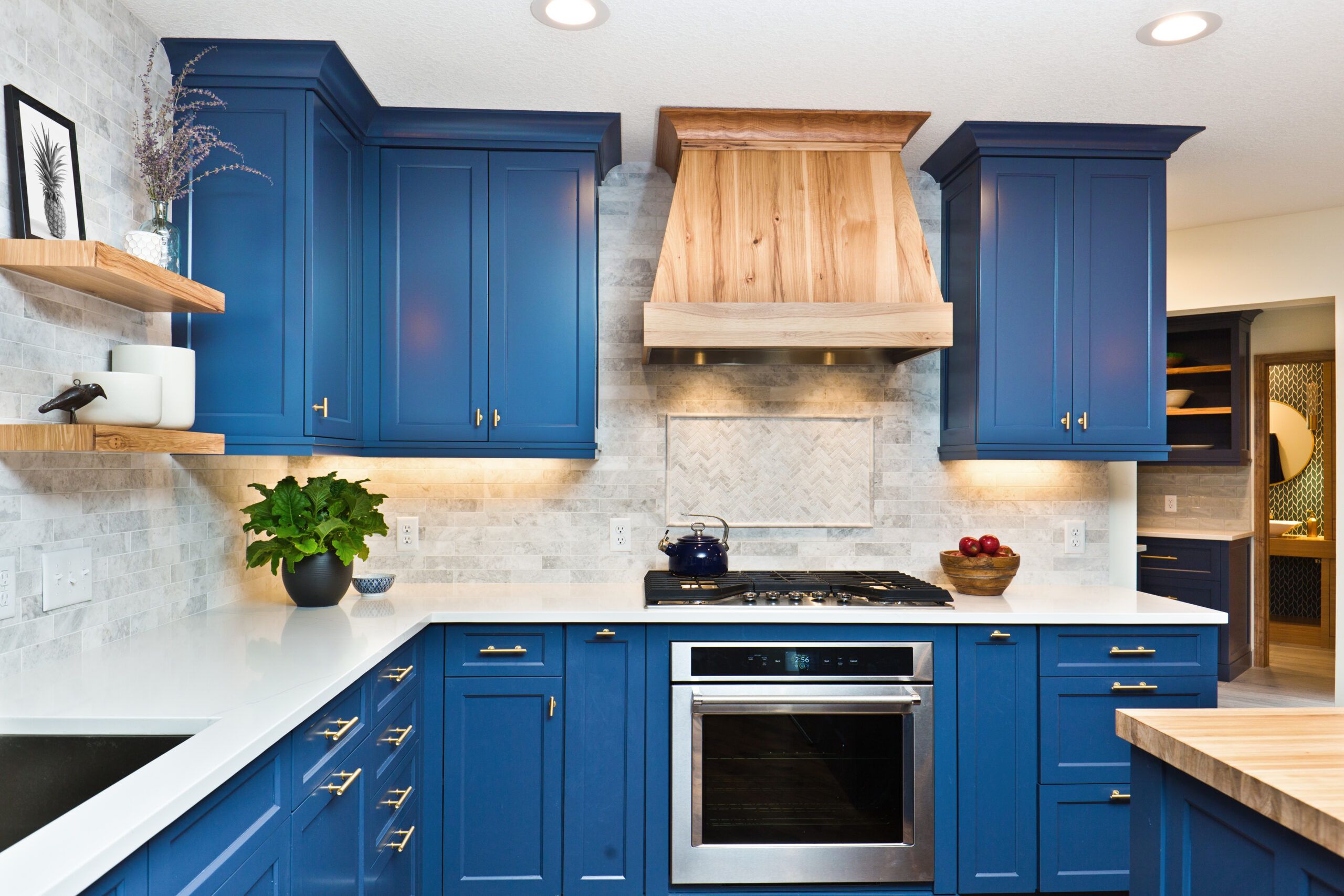On this website, some posts contain affiliate links, which means that if you buy a product using my link, I may earn a commission.
To clean your kitchen, start by clearing the table, doing the dishes, cleaning your stove top and counters, and cleaning the sink. Take out the trash and follow these tips for a sparkling kitchen: clean while you wait, clean the sink after washing up, clean spills immediately, have a place for everything in the kitchen, cover food in the microwave, vacuum instead of sweeping the floor, and regularly clean kitchen cloths.
Replace sponges every few weeks, and follow a step-by-step cleaning checklist for the best order to clean your kitchen. Wipe clean your countertops and wash them with warm soapy water. These simple steps will ensure a clean and organized kitchen.


Credit: www.thisoldhouse.com
What Would You Use To Clean Hardwood Cabinets In The Kitchen?
To clean hardwood cabinets in the kitchen, you can use gentle cleaning products like Mrs. Meyer’s Clean Day Everyday Multi-Surface Cleaner, Method All Purpose Cleaner, or Bar Keepers Friend Soft Cleanser. Additionally, regularly wiping down your cabinets with a damp cloth can help maintain their cleanliness and shine.
How To Clean Hardwood Cabinets In The Kitchen:
Cleaning hardwood cabinets in the kitchen is essential to maintain their appearance and durability. Here are some effective methods to clean your hardwood cabinets:
- Start by dusting the cabinets: Use a soft microfiber cloth or a feather duster to remove any dust or debris from the surface of the cabinets.
- Use a mild detergent and warm water: Mix a few drops of dish soap or a gentle wood cleaner with warm water. Dip a clean cloth or sponge into the solution and wring out any excess liquid. Wipe down the cabinets, making sure to clean both the interior and exterior surfaces.
- Avoid excessive moisture: Hardwood cabinets are susceptible to water damage. Be cautious not to use excessive amounts of water or leave the cabinets wet for a prolonged period. Immediately wipe away any spills or liquid residue.
- Remove tough stains: If you encounter stains or grime that are hard to remove with a mild detergent, try using a mixture of baking soda and water. Gently scrub the stained area with a soft cloth or sponge, then rinse with clean water and dry thoroughly.
- Polish the cabinets: After cleaning, you can use a high-quality wood polish or wax to enhance the cabinets’ shine and protect the wood. Follow the instructions on the product label for the best results.
Remember to always test any cleaning solution or polish on a small, inconspicuous area of your hardwood cabinets before using it on the entire surface. This will help you ensure that the product does not cause any damage or discoloration.
By following these steps, you can keep your hardwood cabinets clean and well-maintained for years to come.
How To Clean Kitchen Cabinets
To clean kitchen cabinets, start by clearing the table and doing the dishes. Then, clean the stove top, wipe down the counters, and clean the sink. Finally, take out the trash for a sparkling kitchen.
Cleaning kitchen cabinets is an essential part of maintaining a clean and organized kitchen. Over time, cabinets can accumulate dirt, grease, and grime, making them look dull and dirty. Follow these steps to ensure that your kitchen cabinets are sparkling clean:
- Remove all items from the cabinets: Before cleaning your kitchen cabinets, take out all the items stored inside. This will allow you to clean the cabinets thoroughly and also give you the opportunity to declutter and organize your kitchen essentials.
- Dust off the cabinets: Use a soft cloth or a duster to remove any dust or debris that has accumulated on the surface of the cabinets. Pay attention to the corners and crevices where dirt tends to accumulate.
- Prepare a cleaning solution: Mix a few drops of mild dish soap with warm water to create a gentle cleaning solution. Avoid using harsh chemicals or abrasive cleaners that can damage the finish of your cabinets.
- Wipe down the cabinets: Dip a clean cloth or sponge into the cleaning solution and wring out any excess liquid. Gently wipe down the exterior surface of the cabinets, working from top to bottom. Be sure to clean the edges, handles, and knobs as well.
- Focus on tough stains or grease buildup: For stubborn stains or grease buildup, you may need to use a slightly stronger cleaning solution. Mix equal parts vinegar and water, or try using a non-abrasive kitchen cleaner. Apply the solution to a cloth and gently scrub the affected areas.
- Rinse and dry: After cleaning the cabinets, rinse off any residue with a clean damp cloth. Then, using a dry cloth, thoroughly dry the cabinets to prevent water damage.
- Clean the interior and shelves: Don’t forget to clean the inside of your kitchen cabinets as well. Remove any shelf liners or drawer liners and wash them accordingly. Wipe down the interior of the cabinets, making sure to remove any crumbs or spills.
- Organize and declutter: Once the cabinets are clean, take the opportunity to organize your kitchen essentials. Consider using organizing bins or dividers to maximize space and keep everything in its place.
- Routine maintenance: To keep your kitchen cabinets looking clean and fresh, it’s important to establish a routine cleaning schedule. Regularly dust and wipe down the cabinets, and promptly clean up any spills or stains.
By following these steps, you can ensure that your kitchen cabinets stay clean and well-maintained. A clean kitchen will not only look visually pleasing but also create a hygienic and inviting space for all your culinary adventures.
How Can I Clean Kitchen Counter Grout?
To clean kitchen counter grout, mix a paste of baking soda and water and scrub it onto the grout. Let it sit for a few minutes, then scrub with a brush and rinse thoroughly. Another option is to use a grout cleaner specifically designed for kitchen surfaces.
Grout is the material used to fill the gaps between tiles, and over time it can become dirty and stained. Cleaning kitchen counter grout is a necessary task to maintain a clean and hygienic kitchen. Here are some tips and methods to effectively clean kitchen counter grout:
- Use a mixture of baking soda and water: Create a paste by mixing baking soda and water until it forms a thick consistency. Apply the paste on the grout lines and let it sit for about 15-20 minutes. Then, scrub the grout with a toothbrush or a grout brush. Rinse with water to remove the residue.
- Use vinegar and water solution: Mix equal parts of vinegar and water in a spray bottle. Spray the solution directly onto the grout lines and let it sit for a few minutes. Scrub the grout with a brush and rinse with water.
- Use hydrogen peroxide: Hydrogen peroxide is effective at removing stubborn stains on grout. Apply hydrogen peroxide directly onto the grout lines and let it sit for 10-15 minutes. Scrub the grout with a brush and rinse with water.
- Use a commercial grout cleaner: There are several commercially available grout cleaners that you can use to clean kitchen counter grout. Follow the instructions on the product and use a brush or sponge to scrub the grout. Rinse with water after cleaning.
Remember to wear gloves and ensure proper ventilation when using cleaning products. Regular maintenance and cleaning of kitchen counter grout will help keep your kitchen looking clean and hygienic.
Why Is It Important To Take Kitchen Equipment Apart Before Cleaning It?
Taking apart kitchen equipment before cleaning it is important because it allows for a more thorough and effective cleaning. By disassembling the equipment, you can reach all the nooks and crannies where grease and dirt can accumulate, ensuring a clean and sanitary kitchen environment.
Taking kitchen equipment apart before cleaning it is an essential step to ensure a thorough and effective cleaning process. Here’s why:
- Prevents residue and buildup: Disassembling kitchen equipment allows you to reach every nook and cranny, removing any food residue, grease, or grime that may have accumulated over time. This helps prevent the buildup of bacteria and mold, ensuring a clean and hygienic kitchen.
- Ensures proper cleaning: By taking apart kitchen equipment, you can clean each component individually, ensuring that every surface is thoroughly cleaned. This is especially important for appliances with multiple parts, such as blenders or mixers, where food particles can easily get trapped.
- Extends the lifespan of equipment: Regularly disassembling and cleaning kitchen equipment helps remove any trapped debris that could potentially damage the components. By taking this preventive measure, you can extend the lifespan of your equipment and avoid costly repairs or replacements.
- Improves performance: When kitchen equipment is properly cleaned, it can function at its best. By removing any buildup, you can optimize the performance of appliances such as ovens, stovetops, or dishwashers, ensuring they work efficiently and deliver optimal results.
- Enhances food safety: Kitchen equipment that is not properly cleaned can harbor bacteria and cross-contamination risks. By disassembling and cleaning each component, you reduce the chances of foodborne illnesses and ensure the safety of the food you prepare.
- Facilitates maintenance and repairs: Taking kitchen equipment apart before cleaning not only helps with regular maintenance but also makes it easier to identify any issues or damages. This allows you to address them promptly, preventing further damage and ensuring the equipment operates smoothly.
- Provides an opportunity for deep cleaning: Disassembling kitchen equipment gives you the chance to deep clean hard-to-reach areas, such as crevices or filters. This ensures a more thorough cleaning and removes any hidden dirt that regular surface cleaning may miss.
- Promotes a clean and organized kitchen: By regularly taking kitchen equipment apart for cleaning, you create a habit of cleanliness that extends beyond just the equipment itself. It encourages a clean and organized kitchen environment, making meal preparation more enjoyable and efficient.
- Complies with health and safety regulations: In commercial kitchens, proper cleaning and hygiene practices are crucial for complying with health and safety regulations. Taking kitchen equipment apart before cleaning is an essential step to maintain a clean and safe working environment.
- Improves overall efficiency: When kitchen equipment is cleaned and maintained properly, it operates more efficiently, saving energy and reducing operational costs. This can have a positive impact on your overall kitchen productivity and budget.
Taking kitchen equipment apart before cleaning may require a bit more time and effort, but the benefits it brings in terms of cleanliness, functionality, and longevity make it well worth it. By following this practice, you can ensure a clean, safe, and efficient kitchen environment.
How To Clean Kitchen Cabinets Grease
To clean kitchen cabinets grease, start by clearing out the cabinets and removing all items. Mix a solution of equal parts vinegar and water, and use a microfiber cloth to wipe down the surfaces, paying extra attention to greasy areas.
For stubborn stains, make a paste with baking soda and water and gently scrub the cabinets. Rinse with a clean cloth and dry thoroughly.
How To Clean Kitchen Cabinets Grease:
Cleaning kitchen cabinets can be a daunting task, especially when it comes to tackling grease buildup. Grease can accumulate on cabinets over time, making them look dirty and dull. However, with the right techniques and cleaning solutions, you can easily remove grease from your kitchen cabinets and restore their shine.
Here are some effective methods to clean kitchen cabinets grease:
- Vinegar and water solution: Mix equal parts of white vinegar and water in a spray bottle. Spray the solution onto the greasy cabinets and let it sit for a few minutes. Use a microfiber cloth to scrub the grease gently in circular motions. Wipe off the residue with a clean cloth.
- Baking soda paste: Make a paste by combining baking soda and water. Apply the paste to the greasy areas of the cabinets and let it sit for 10-15 minutes. Scrub the grease using a soft-bristled brush or sponge. Rinse off the paste with warm water and dry the cabinets thoroughly.
- Dish soap and warm water: Fill a bucket with warm water and add a few drops of dish soap. Dip a sponge or cloth into the soapy water and wring out the excess. Gently scrub the greasy cabinets, paying extra attention to the areas with heavy grease buildup. Rinse the cabinets with clean water and dry them with a soft cloth.
- Commercial degreasers: If the grease is stubborn and difficult to remove, you can use a commercial degreaser specifically designed for kitchen cabinets. Follow the instructions on the product label for the best results. Remember to ventilate the area properly and wear gloves while using chemical cleaners.
- Regular maintenance: To prevent grease buildup on your cabinets, it’s important to maintain a regular cleaning routine. Wipe down the cabinets regularly with a damp cloth to remove any surface grease. Avoid using abrasive cleaners or scrub brushes that can damage the finish of the cabinets.
By using these methods and incorporating regular maintenance, you can keep your kitchen cabinets grease-free and looking their best. Remember to evaluate the type of cabinets you have (wood, laminate, etc. ) And test any cleaning solution on a small, inconspicuous area before applying it to the entire surface.
With a little effort and the right techniques, you can restore the beauty of your kitchen cabinets and create a clean and inviting space.
Frequently Asked Questions For Clean Kitchen All Answer
What Are The 7 Steps Of Cleaning Kitchen?
To clean a kitchen, follow these steps: 1. Clear the table. 2. Do the dishes. 3. Clean the stove top and wipe down the counters. 4. Clean the sink. 5. Take out the trash. 6. Clean while you wait. 7.
Clean spillages as soon as possible. That’s it!
What Are The 10 Ways To Clean Your Kitchen?
Here are 10 ways to clean your kitchen effectively: 1. Clear the table and do the dishes. 2. Clean your stove top and wipe down your counters. 3. Clean the sink and take out the trash. 4. Clean spillages and cover food when using the microwave.
5. Have a designated place for everything in the kitchen. 6. Vacuum the kitchen floor instead of sweeping. 7. Regularly clean kitchen cloths and replace sponges every few weeks. 8. Follow a step-by-step cleaning checklist for the kitchen. 9. Keep countertops clutter-free and wash them with warm soapy water.
10. Maintain a clean kitchen to ensure hygiene and a pleasant cooking experience.
What Are The 5 Steps In Cleaning Kitchen?
To clean a kitchen, follow these 5 steps: 1. Clear the table 2. Do the dishes 3. Clean stove top and wipe down counters 4. Clean the sink 5. Take out the trash
What Are 4 Ways To Be Clean In The Kitchen?
To keep your kitchen clean, follow these four steps: 1. Clear the table and do the dishes. 2. Clean stove top, wipe down counters, and the sink. 3. Take out the trash. 4. Clean spillages immediately, have a place for everything, and regularly clean kitchen cloths.
Conclusion
Keeping your kitchen clean and organized is essential for a healthy and efficient cooking space. By following the step-by-step cleaning guide and incorporating the best advice, you can maintain a spotless kitchen. Remember to clear the table, do the dishes, clean your stove top and counters, and regularly clean the sink.
Additionally, clean spillages immediately, cover food when using the microwave, and vacuum the kitchen floor. By implementing these tips, you can ensure a clean and enjoyable cooking environment.
On this website, some posts contain affiliate links, which means that if you buy a product using my link, I may earn a commission.

